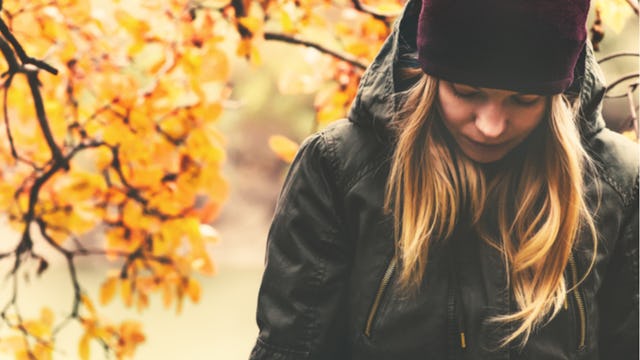PSA: Not Everyone Loves Fall, And Here's Why

I see it every year—while most people are celebrating the cooler temperatures and the changing colors, others are slipping away. It’s this shift in seasons—from Summer to Fall—that sends so many into a depressive spiral.
For some it’s the shorter days and less sunlight that gives way to seasonal affective disorder (SAD). SAD is a form of depression that often starts in the fall, carries through winter, and resolves during the Spring and Summer seasons. The pattern of SAD gives it a unique name, but don’t let it fool you, the symptoms are much the same as classic depression. Feeling depressed, hopeless or worthless, loss of energy, trouble sleeping, irritability, and/or losing interest in things you once enjoyed. SAD can even bring about thoughts of dying or suicide.
Fall also marks the begin of the holiday season, which can be a painful reminder of what we don’t have, or who we don’t have. Fall reminds us of people who aren’t here to share the season. People who won’t be there for Friday night football games, bonfires, or holiday gatherings. It reminds us of people we lost too soon, people no longer in our lives because of toxic relationships, or people who never were. Babies who were never born—who will never wear specially selected holiday outfits or jump in freshly raked piles of leaves. Or, for some, this season is a painful reminder of the scars that forever changed our hearts.
Fall can be a time when depression grabs hold and refuses to let go. It can be a season of loneliness and longing. A season of sadness, but also so much more than just sadness. It’s a feeling of numbness that can’t be explained. It settles in your bones and pulls the light from your eyes. It’s an emotional depletion that leaves you feeling empty, even if your life is full. You aren’t allowed a choice in the matter—you are simply a passenger waiting for the ride to end. You move from day to day, merely existing, praying the fog will lift.
It’s easy to pull on a pair of sweatpants and ride the season out alone. To hunker down and avoid the season that causes you to feel broken, because let’s be honest, you don’t have the energy to be around people anyway. They will ask questions you don’t really know how to answer. They will ask, “what’s wrong,” as though you have the ability to explain. Maybe this is why so many people seek solitude in the fall.
It looks different from the outside—when you aren’t the one lost in the fog, but instead, the one watching a friend be pulled away. Sometimes it looks like sadness or avoidance. Sometimes anger or frustration. But it’s not personal, it’s not something you’ve done or haven’t done—it’s the fog.
When you notice a change in someone, be sensitive. Be patient and accepting. Check in on them, bring them coffee, or invite them out. They may not come, but your effort won’t go unnoticed. Don’t worry about having the answers or trying to fix the problem, just be there.
Remember that in this season of celebration, not everyone is celebrating. Not everyone is setting a table for friends and family or posting pictures of their babies trick-or-treating. Remember that some people are caught in the undertow, and the next several months will likely be a fight you know nothing about. Don’t assume what you don’t know, give everyone the benefit of the doubt. Be the first to smile when you pass a stranger on the street, hold open a door, or give your seat to someone on the bus. Go the extra mile to be kind and sensitive, because you never know who really needs it.
Fall is not magical for everyone, watch out for those in the fog.
If you or someone you know is experiencing a mental health crisis or is having thoughts of suicide, please contact the National Crisis Line at 1-800-273-8255. You are never alone.
This article was originally published on